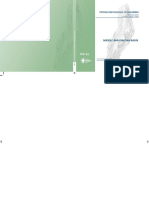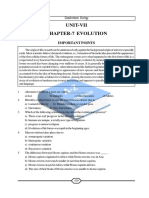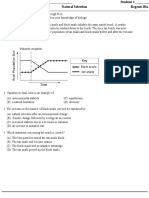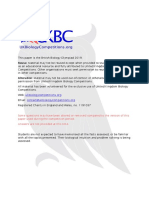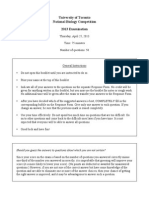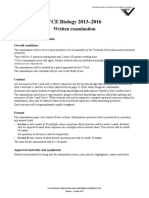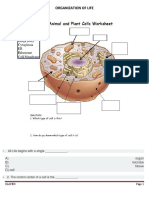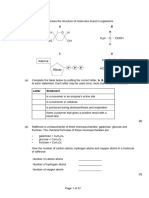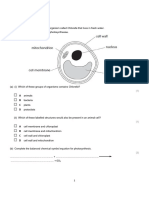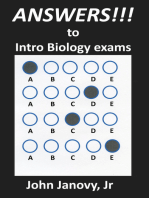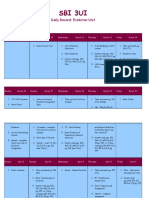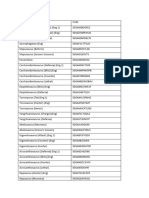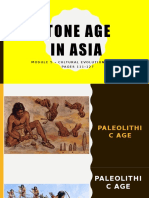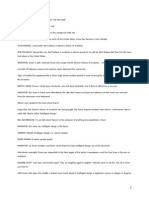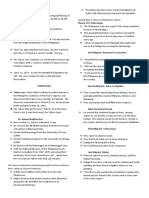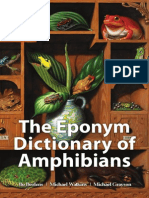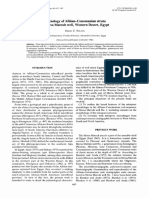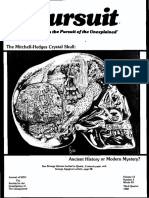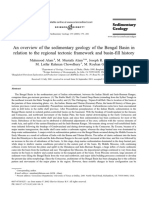Evolution Test 2012
Evolution Test 2012
Uploaded by
369220Copyright:
Available Formats
Evolution Test 2012
Evolution Test 2012
Uploaded by
369220Copyright
Available Formats
Share this document
Did you find this document useful?
Is this content inappropriate?
Copyright:
Available Formats
Evolution Test 2012
Evolution Test 2012
Uploaded by
369220Copyright:
Available Formats
Name: ______________________ Class: _________________
Date: ____________________ Ms. Williams ID: A
Evolution-Natural Selection and Evolution of Populations
Multiple Choice-ANSWER ALL MULTIPLE CHOICE QUESTIONS. Identify the choice that best completes the statement or answers the question. 1 The species of finches that Charles Darwin found on different Galpagos Islands varied in certain structural adaptations. One of the most significant adaptations that Darwin noted was the A similarities of the birds embryos. B birds different-shaped beaks. C length of the birds necks. D number of eggs in each birds nest. Based on the adaptations Charles Darwin observed in finches and tortoises in the Galpagos, he wondered F if species living on different islands had once been members of the same species. G if finches and tortoises had originated from the same ancestral species. H if all birds on the different islands were finches. J why all tortoises on the different islands were identical. Charles Darwins observation that finches of different species on the Galpagos Islands have many similar physical characteristics supports the hypothesis that these finches A have the ability to interbreed. B acquired traits through use and disuse. C all eat the same type of food. D descended from a common ancestor. On the Galpagos Islands, Charles Darwin observed F completely unrelated species on each of the islands. G species exactly like those found in South America. H species similar to mainland South American species. J species completely unrelated to those found in South America. James Huttons and Charles Lyells work was important to Darwin because these scientists A explained volcanoes and earthquakes. B explained all geologic events on Earth. C suggested that Earth was old enough for evolution to have occurred. D refuted the work of Lamarck, which was based on misunderstandings. What did Charles Darwin learn from reading the work of James Hutton and Charles Lyell? F Earth is relatively young. G Gradual change operating over long periods of time can result in dramatic changes. H All geological change is caused by living organisms. J The processes that formed old rocks on Earth do not operate today.
Name: ______________________ 7
ID: A
Lamarcks ideas about evolution include the concept that differences among the traits of organisms arise as a result of A continual increases in population size. B the actions of organisms as they use or fail to use body structures. C an unchanging local environment. D the natural variations already present within the population of organisms. In an experiment, suppose that the wings of fruit flies were clipped short for fifty generations. The fifty-first generation emerged with normal-length wings. This observation would tend to disprove the idea that evolution is based on F inheritance of natural variations. G inheritance of acquired characteristics. H natural selection. J survival of the fittest. Darwin realized that the economist Malthuss theory of population control A applied only to humans. B could be generalized to any population of organisms. C could be generalized only when populations lived in crowded conditions. D explained why the number of deaths exceeded that of births. When farmers select animals or plants to use for breeding, they look for F species that are perfect and unchanging. G homologous structures. H characteristics acquired during the lifetime of the organism. J natural variations that are present in a species. The number and location of bones of many fossil vertebrates are similar to those in living vertebrates. This is evidence in support of which of the following concepts? A Lamarcks tendency towards perfection B common descent C analogous structures D the inheritance of acquired traits
10
11
Name: ______________________
ID: A
Figure 161 12 In humans, the pelvis and femur, or thigh bone, are involved in walking. In whales, the pelvis and femur shown in Figure 161 are F examples of fossils. G vestigial structures. H acquired traits. J examples of natural variation. Molecular evidence in support of natural selection includes A the nearly universal genetic code. B the presence of vestigial structures. C a tendency toward perfect, unchanging DNA in various species. D the transmission of acquired characteristics by DNA. Similar patterns of embryological development in different but related organisms are responsible for the formation of F homologous structures. G analogous structures. H Hox genes. J intermediate fossil forms. Natural selection acts directly on A alleles. B genes. C phenotypes. D mutations. Three sources of genetic variation are F genotypes, phenotypes, and polygenic traits. G sexual reproduction, lateral gene transfer, and mutations. H single-gene traits, polygenic traits, and adaptation. J directional selection, disruptive selection, and stabilizing selection.
13
14
15
16
Name: ______________________
ID: A
Figure 171 17 One end of Figure 171 shows an increase in average beak size for a population of birds. When individuals at only one end of a bell curve of phenotype frequencies have high fitness, the result is A directional selection. B stabilizing selection. C disruptive selection. D genetic drift.
Figure 172 18 Figure 172 shows highest fitness toward the center of the curve. When individuals with an average form of a trait have the highest fitness, the result is F not predictable. G disruptive selection. H directional selection. J stabilizing selection.
Name: ______________________ 19
ID: A
If a mutation introduces a new skin color in a lizard population, which factor might determine whether the frequency of the new allele will increase? A how many other alleles are present B whether the mutation makes some lizards more fit for their environment than other lizards C how many phenotypes the population has D whether the mutation was caused by nature or by human intervention In F G H J genetic drift, the allele frequencies in a gene pool change because of mutations. chance. natural selection. genetic equilibrium.
20
21
Which of the following events do biologists consider a random change? A directional selection B speciation C disruptive selection D genetic drift The type of genetic drift that follows the colonization of a new habitat by a small group of individuals is called F mutatino G the founder effect. H directional selection. J stabilizing selection.
22
Name: ______________________
ID: A
Short Answer-ANSWER 2 QUESTIONS FOR CREDIT. YOU MAY COMPLETE THE LAST QUESTION FOR EXTRA CREDIT. 23 Would a trait that has only two distinct phenotypes more likely be a single-gene trait or a polygenic trait? How do you know?
a 24 Is an allele for a trait that has no effect on a species fitness affected by natural selection? Explain.
Name: ______________________ 25
ID: A
What are three mechanisms for reproductive isolation? Which mechanism isolates two populations of similar frogs with different mating calls?
Name: ______________________
ID: A
DIAGRAMS-ANSWER 2 QUESTIONS FOR CREDIT. YOU MAY COMPLETE THE LAST QUESTION FOR EXTRA CREDIT. Comparison of Two Vertebrates Characteristics Habitat Type of Vertebrate Composition of Skeleton Type of Teeth Respiration Fish Cartilage Large numbers of sharp teeth Breathes in water Shark Ocean Dolphin Ocean Mammal Bone Large numbers of sharp teeth Breathes in air
Figure 163 26 Compare and Contrast In Figure 163, sharks and dolphins belong to different vertebrate groups and are not closely related. How can Darwins ideas about evolution help explain their similar appearance?
a 27 Charles Darwin would say that sharks like the one in Figure 163 exhibit fitness. Explain what that means, and discuss two specific adaptations as part of your explanation.
Name: ______________________ 28
ID: A
Apply Concepts Fossil evidence indicates that dolphins evolved from ancestors that walked on land. How can the concept of natural selection be used to explain the evolution of the present-day dolphin body, as seen in Figure 163?
Name: ______________________ Extended Response- ANSWER 1 QUESTION ONLY. 29
ID: A
What might happen if a well-adapted population experienced sudden major changes in its environment?
Figure 165 30 How is the idea of common descent supported by examples of homologous structures as shown in Figure 165?
10
You might also like
- Dinosaur Fact CardsDocument3 pagesDinosaur Fact CardsJuliana Montenegro Brasileiro100% (3)
- Speciation Evolution Questions From Vcaa Exams No AnswersDocument36 pagesSpeciation Evolution Questions From Vcaa Exams No Answersapi-295891960100% (1)
- All A Topic TestsDocument20 pagesAll A Topic TestsSameer Sarna100% (1)
- Volumen 11 Middle-Magdalena BasinDocument193 pagesVolumen 11 Middle-Magdalena BasinZareth67% (3)
- 1575 IUCN 2240 en PDFDocument10 pages1575 IUCN 2240 en PDFAzizipho PotwanaNo ratings yet
- Unit-Vii Chapter-7 Evolution: Important PointsDocument22 pagesUnit-Vii Chapter-7 Evolution: Important PointsBrasa Y. de AlmiraNo ratings yet
- Natural Selection QuestionsDocument4 pagesNatural Selection Questionsapi-299996815100% (1)
- Ecology Practice Questions 2Document19 pagesEcology Practice Questions 2Fares ElgalladNo ratings yet
- BBO2019Document49 pagesBBO2019qiuNo ratings yet
- Unit 10 - Ecology - Revision Ws - 2 - MSDocument6 pagesUnit 10 - Ecology - Revision Ws - 2 - MSAyesha MahboobNo ratings yet
- TSSM Unit Two Exam 2016Document22 pagesTSSM Unit Two Exam 2016nisulNo ratings yet
- Entrance Exam 2014 15Document33 pagesEntrance Exam 2014 15ly nguyendoanNo ratings yet
- No of Printed Pages: 4Document4 pagesNo of Printed Pages: 4shannonjohnlewis34No ratings yet
- CET Biology GT 14.07.2024Document7 pagesCET Biology GT 14.07.2024mshrinivas878No ratings yet
- Section Assignement 1 - Graphing and StatsDocument7 pagesSection Assignement 1 - Graphing and StatsDavina SuseloNo ratings yet
- s6 Biology Paper 1Document19 pagess6 Biology Paper 1Tusiime RobertNo ratings yet
- Nseb 18-19Document24 pagesNseb 18-19sunilsigmaNo ratings yet
- NSE 2019 Biology Paper With AnswerDocument18 pagesNSE 2019 Biology Paper With AnswerNeetu WaliaNo ratings yet
- 2006 Assessment 2006 Biology GA 3: Written Examination General CommentsDocument7 pages2006 Assessment 2006 Biology GA 3: Written Examination General Commentspjb_94No ratings yet
- 2011 HSC Exam BiologyDocument36 pages2011 HSC Exam BiologyWayiz AliNo ratings yet
- NSEB-2023 SolutionsDocument16 pagesNSEB-2023 Solutionstusharkantighosh1111No ratings yet
- 6.2 Inheritance Variation and Evolution Variation and Evolution Standard Demand QsDocument24 pages6.2 Inheritance Variation and Evolution Variation and Evolution Standard Demand Qs06hoqueaNo ratings yet
- N5 Biology 2014Document41 pagesN5 Biology 2014FarooqAhmadLashariNo ratings yet
- Populationsinecosystems Part 2Document94 pagesPopulationsinecosystems Part 2/ “Nu” /No ratings yet
- INBO2018 Solution 20180213Document10 pagesINBO2018 Solution 20180213Abhik Kumar MajiNo ratings yet
- Evolution 1Document15 pagesEvolution 1Somitha Sree.SNo ratings yet
- 2024 Jun U1Document28 pages2024 Jun U1shasmibala910No ratings yet
- Biocomp Exam 2013Document11 pagesBiocomp Exam 2013e100% (1)
- Mybio11 ExamDocument28 pagesMybio11 ExamEren SevinceNo ratings yet
- Science SQP-01 2024Document13 pagesScience SQP-01 2024badasserytechNo ratings yet
- Question BankDocument83 pagesQuestion BankSulagnaNo ratings yet
- Bio G9 T3 P1Document16 pagesBio G9 T3 P1Leena BhaiNo ratings yet
- Biology Specs Samp W PDFDocument43 pagesBiology Specs Samp W PDFedeceNo ratings yet
- N5 Biology All 2018Document48 pagesN5 Biology All 2018Sajida CheemaNo ratings yet
- Biology SQP-01 2024 ExamDocument8 pagesBiology SQP-01 2024 ExamananyainwydNo ratings yet
- d0846503 Bio ch18 B 2 Files MergedDocument9 pagesd0846503 Bio ch18 B 2 Files Mergedapi-364565466100% (1)
- 3.8.2 Gene Expression - 26 MarksDocument8 pages3.8.2 Gene Expression - 26 MarksalaynasharleezNo ratings yet
- 4.3 Classification and EvolutionDocument109 pages4.3 Classification and Evolutiontaaniya sadiq100% (1)
- Organization of LifeDocument6 pagesOrganization of LifeVina SihombingNo ratings yet
- N5 Biology Section1 2021Document12 pagesN5 Biology Section1 2021BlanchevideNo ratings yet
- Heart, Blood Vessesls and Blood WorksheetDocument4 pagesHeart, Blood Vessesls and Blood WorksheetJoanne MullengerNo ratings yet
- L A Level Biology MS Jan 06Document180 pagesL A Level Biology MS Jan 06zetsubou-chanNo ratings yet
- Revision Handout Edexcel IGCSE Human Biology November 2024Document147 pagesRevision Handout Edexcel IGCSE Human Biology November 2024Sk Jaoata AfnanNo ratings yet
- Muscle Function Exam QuestionsDocument11 pagesMuscle Function Exam QuestionsV1 wolvoNo ratings yet
- 0680_m24_qp_12Document20 pages0680_m24_qp_12breshnaimran321No ratings yet
- Class Xi Final Biology 2022-23Document8 pagesClass Xi Final Biology 2022-23Mehak ShireenNo ratings yet
- 11 Bio Yrly Exam 09 QuestionsDocument11 pages11 Bio Yrly Exam 09 QuestionsJay Li100% (1)
- 2008 Biology: InsightDocument23 pages2008 Biology: InsightXavier GavinNo ratings yet
- A01 Short Answer QuestionsDocument29 pagesA01 Short Answer Questionsmsuria06No ratings yet
- A-Level Biology Protein Exam QuestionsDocument27 pagesA-Level Biology Protein Exam Questionsfreyamartin90676100% (1)
- Ecology - QuizizzDocument3 pagesEcology - QuizizzArina KhusnaNo ratings yet
- BIOL 203 Spring 2015 Mock FinalDocument6 pagesBIOL 203 Spring 2015 Mock FinalMASNo ratings yet
- Paper Practice Test With KEY AttachedDocument8 pagesPaper Practice Test With KEY AttachedmspallardNo ratings yet
- Nseb 2012 QPDocument15 pagesNseb 2012 QPSanjana Mehta100% (1)
- IGedex2122 2.18-2.23 PhotosynDocument17 pagesIGedex2122 2.18-2.23 PhotosynrkblsistemNo ratings yet
- MCQ-1Document78 pagesMCQ-1zyad reda eldahrawyNo ratings yet
- Genetic Diversity and Adaptation Part 2Document88 pagesGenetic Diversity and Adaptation Part 2kafiazabit200No ratings yet
- L7 4 Exam Qu NTDocument12 pagesL7 4 Exam Qu NTw.lamNo ratings yet
- 2.1 Cell Structure QPDocument12 pages2.1 Cell Structure QPByron Java100% (1)
- INBO Solution 20190219Document12 pagesINBO Solution 20190219svsvidyasagarNo ratings yet
- Evolution Practice Test 2 With AnswersDocument10 pagesEvolution Practice Test 2 With AnswersSuhani SinhaNo ratings yet
- Master Homo Sapien Sapiens Detailed InputDocument3 pagesMaster Homo Sapien Sapiens Detailed Inputapi-194762500No ratings yet
- Sharks 5Document2 pagesSharks 5ruchinidissanayakeNo ratings yet
- Soal Ulangan Harian Bahasa Inggris Kelas 9Document14 pagesSoal Ulangan Harian Bahasa Inggris Kelas 9de rantiNo ratings yet
- Sbi3ui DR EvolutionDocument3 pagesSbi3ui DR Evolutionapi-234678275No ratings yet
- Sankalp Foundation: BiologyDocument4 pagesSankalp Foundation: BiologyShreyansh DuggarNo ratings yet
- DK All Codes.Document23 pagesDK All Codes.mdhd1467No ratings yet
- A History of Geology and Medicine PDFDocument80 pagesA History of Geology and Medicine PDFIsrael Hinestroza50% (2)
- Fish Classification, StructureDocument40 pagesFish Classification, StructureBio SciencesNo ratings yet
- Stone Age in AsiaDocument26 pagesStone Age in AsiaOphlynne PCNo ratings yet
- My Evs ReportDocument16 pagesMy Evs ReportVenkateshGundaNo ratings yet
- Newsademic 311Document22 pagesNewsademic 311rodrigocorreaaranedaNo ratings yet
- Trace Fossils and Bioturbation: The Other Fossil RecordDocument22 pagesTrace Fossils and Bioturbation: The Other Fossil RecordIrzan fajarNo ratings yet
- Judgement Day Intelligent Design Trial TranscriptDocument36 pagesJudgement Day Intelligent Design Trial TranscriptChristine CarreonNo ratings yet
- Tabon Cave: Land Bridge or Waves of Migration TheoryDocument2 pagesTabon Cave: Land Bridge or Waves of Migration TheoryJerome SurimaNo ratings yet
- Year 8 - Rocks and Weathering - The Rock CycleDocument10 pagesYear 8 - Rocks and Weathering - The Rock CycleBioScMentor-1No ratings yet
- Dolomitizatio, Qamch, 2010, GeoArabiaDocument28 pagesDolomitizatio, Qamch, 2010, GeoArabiaericespirituNo ratings yet
- Eponym Dictionary of Amphibians - Contents and Sample ChapterDocument17 pagesEponym Dictionary of Amphibians - Contents and Sample ChapterPelagic PublishingNo ratings yet
- Sultan 1987Document11 pagesSultan 1987ahmedNo ratings yet
- Tanawal FormaionDocument2 pagesTanawal FormaionArsalan Khan100% (1)
- 04 Vaca Muerta Shale PDFDocument14 pages04 Vaca Muerta Shale PDFsanty222No ratings yet
- NCERT Solutions For Class 6 April 3 Science Chapter 8 Body MovementsDocument3 pagesNCERT Solutions For Class 6 April 3 Science Chapter 8 Body MovementsDebasish BagNo ratings yet
- PURSUIT Newsletter No. 59, Third Quarter 1982 - Ivan T. SandersonDocument52 pagesPURSUIT Newsletter No. 59, Third Quarter 1982 - Ivan T. Sandersonufortean100% (1)
- Earth and Life Science: Quarter 1 - Module 14: Geologic TimelineDocument26 pagesEarth and Life Science: Quarter 1 - Module 14: Geologic Timelinehara azurNo ratings yet
- Alam Et Al 2003Document30 pagesAlam Et Al 2003Furious SKNo ratings yet
- Geologic Time Scale: Quarter 2 MODULE 9: 11th GradeDocument10 pagesGeologic Time Scale: Quarter 2 MODULE 9: 11th GradeMadheline OcoNo ratings yet
- Raz Li33 Discoveringdinosaurs CLRDocument9 pagesRaz Li33 Discoveringdinosaurs CLRNatalia Castro100% (1)
- Evolution, Evidence and Mechamisms: Student Practice SheetDocument4 pagesEvolution, Evidence and Mechamisms: Student Practice SheetNoura RoseNo ratings yet



